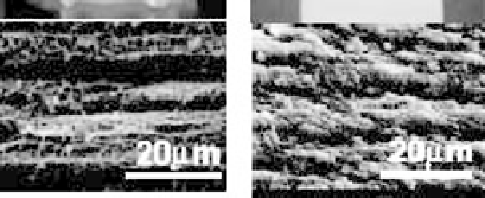Biomedical Engineering Reference
In-Depth Information
Figure9.13
LayeredstructureofBC(left)andBC/gelatincomposite(right)(39).(Nakayama,
A.; Kakugo, A.; Gong, J.P. etal., High mechanical strength double-network hydrogel with
bacterial cellulose. Advanced Functional Materials, 2004, 14(11), 1124-8. Copyright John
Wiley&Sons-VCHVerlagGmbH&Co.KGaA.Reproducedwithpermission.)
biomedical applications. To remedy this disadvantage, Nakayama
et al
. have immersed
a purified BC pellicle in a gelatin solution after which it was chemically crosslinked
to various crosslinking densities (39). The resulting double networks (DN) combined
the outstanding tensile properties of BC with very high compressive strength. The DN
showed a stratified structure similar to that of BC, consisting of dense and sparse layers
of cellulose fibers (Figure 9.13). The gelatin did not affect the crystalline structure of
BC and was proposed to fill in the cellulose-poor layers. The improvement in properties
imparted by the combination of these two polymers was outstanding. In the direct
ion perpendicular to the stratified structure of the DN, the compressive modulus was
1.7 MPa, that is over 200 times higher than that of BC alone (Figure 9.14). The fracture
strength of the BC/gelatin network was also very largely improved compared to that of
the gelatin gel alone, being 30 times higher. Furthermore the BC/gelatin hydrogel was
capable of recovery after a first compressive deformation up to 30% strain which was
not the case of neat BC. The authors proposed that in the DN gel, mechanical properties
are mainly dominated by the degree of crosslinking of the gelatin and by the unit ratio
of the second network to the first network (R
amino acid/glucose) (Figure 9.14). As
a result the DN could achieve properties similar to that of articular cartilage.
A recent study also evaluated composites of silk fibroin and BC in the dry and in the
wet state (40). Silk protein, a mixture of glycine, alanine and serine, can take various
conformations, amorphous and crystalline, and has generated interest in the biomedical
field as membranes due to its biocompatibility, permeability in the wet state and high
mechanical properties. The authors therefore prepared BC/silk fibroin nanocomposites
by immersing a purified and never dried bacterial cellulose pellicle into aqueous silk
fibroin solution (8 wt%) produced from Bombix mori cocoons and by then drying the
nanocomposites into films. Field emission scanning electron microscopy (FESEM) of
fracture surfaces suggested that the silk protein was finely dispersed between the cel-
lulose fibers resulting in well dispersed nanocomposites. Concomitantly, the fibroin
morphology changed from a mostly amorphous coil structure to a crystalline structure
as a
β
-sheet structure as demonstrated by X-ray diffraction and FTIR spectroscopy. As
a result the mechanical properties of the nanocomposites differed from those of the pure
fibroin or bacterial cellulose films. In the dry state, the tensile modulus of the composite
film (465
=
±
57 MPa) was higher than that of the neat BC film (118
±
9 MPa) or silk

Search WWH ::

Custom Search